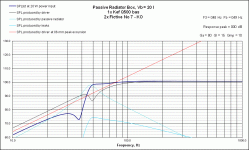You need to measure TS parameters exactly like the video shows. After that, you can return the drivers in to the cabinets and measure the impedances of individual drivers without crossover. You will need it for simulations later. Tweeter is always measured for impedance not for TS. Your woofer and midwoofer needs TS, you can measure it either by added mass or known cabinet volume method.
Last edited:
Could you please have a look at the measurements so I can put the speaker back together?
measurements - Google Drive
measurements - Google Drive
You haven't added any mass to derive Vas. Or at least i don't see it on the pics. Look the dats video again.
I own myself a pair of Q500... did not touch the crossover but changed the internal wiring (original really sucks... thin cheap wires like "door bell wires" as we call them in Germany) to PTFE silver plated (twisted AWG 16 for Woofer and twisted AWG 24 for Uni-Q driver) and output terminals to WBT 0703 Cu. Initially thought about doing some crossover rework but as sound already improved with these minor mods I stopped doing anything more...
I own myself a pair of Q500... did not touch the crossover but changed the internal wiring (original really sucks... thin cheap wires like "door bell wires" as we call them in Germany) to PTFE silver plated (twisted AWG 16 for Woofer and twisted AWG 24 for Uni-Q driver) and output terminals to WBT 0703 Cu. Initially thought about doing some crossover rework but as sound already improved with these minor mods I stopped doing anything more...
Thank you, I was already looking for better wires, so your advice is very useful!
I will check all of these wires.
However, I will finish the measurement, run some simulation, try to design something better, and if it looks much better on paper, then I will try and then share my results with everyone.
Can you please confirm these are the wires what you advised?
24AWG: PTFE silver plated copper wire, 7/0.2 | Hifi Collective
16AWG: PTFE silver plated copper wire, 19/0.30 | Hifi Collective
Last edited:
Last edited:
Thank you, I was already looking for better wires, so your advice is very useful!
I will check all of these wires.
However, I will finish the measurement, run some simulation, try to design something better, and if it looks much better on paper, then I will try and then share my results with everyone.
Can you please confirm these are the wires what you advised?
24AWG: PTFE silver plated copper wire, 7/0.2 | Hifi Collective
16AWG: PTFE silver plated copper wire, 19/0.30 | Hifi Collective
Bought mine from other source (in Germany) but from the data they are the same.
I have recreated response you've measured close enough.
View attachment 749228
When you measure frequency response of raw woofer driver in cabinet, we will merge it with this sim at around 100Hz and get quasi anechoic file for simulators.
Thanks, I was playing with the data in VituixCAD too.
Hopefully I can do the frequency measurement next week, I'm still waiting for response from universities as I hope I can use they anechoic chambers.
Just found this: http://www.kef.com/uploads/files/en/series_pdf/q_tech_explained_010910_en.pdf
Also while I was doing the measurement I noticed this:

Also while I was doing the measurement I noticed this:

Actually my first diagram was not correct. The mid driver is reversed:

Is it something what I should keep in the next design? I still don't understand this concept, could anyone explain to me why is it chosen by anyone?

Is it something what I should keep in the next design? I still don't understand this concept, could anyone explain to me why is it chosen by anyone?
Which part don't you understand ?
The part I don't understand is the reversed midrange driver. Why is it better if is out of phase?
Hi,
If the crossover is 18db ( or 36) /octave it is common to reverse polarity to have (phase) coherency at fc.
If the crossover is 18db ( or 36) /octave it is common to reverse polarity to have (phase) coherency at fc.
Actually KEF often uses acoustically 12dB/octave (LR2) crossovers, which if designed correctly it needs opposite polarity with the next driver in the row to get phase coherency.
Last edited:
This crossover look like first order to me.
First order on the electrical side, which means nothing without the drivers own slopes mounted on the baffle. The acoustical (this is what matters) slope can be nearly anything, but the driver wiring and seeing more KEF lodspeaker measurements suggests that this is a 12dB/octave sloped speaker.
Last edited:
The following pic shows pretty shallow slopes in the crossover region.

I might add a very mild LCR notch ( working between 3-5K ) to remove that bump ( assuming my ears agreed with my eyes ).
🙂

I might add a very mild LCR notch ( working between 3-5K ) to remove that bump ( assuming my ears agreed with my eyes ).
🙂
The part I don't understand is the reversed midrange driver. Why is it better if is out of phase?
I will model their crossover with files that i have but i'm guessing that it works better that way because of the distance of acoustic centers of bassmid and bass in regard to the listener.
- Home
- Loudspeakers
- Multi-Way
- KEF Q500 new crossover



